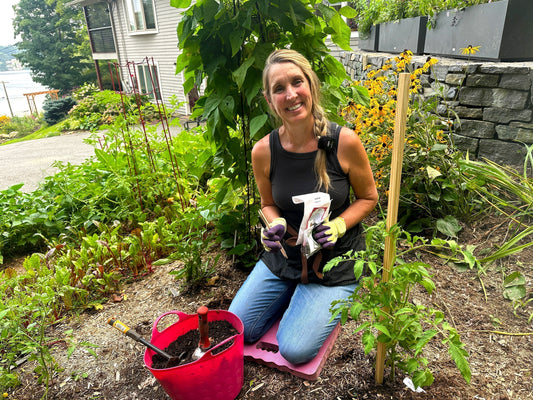The Benefits of Vertical Gardening: Grow More by Maximizing Space
Joshua LagaceIf you have a small yard or outdoor space and you are looking to grow your own food, vertical gardening is for you! It is so easy and has many benefits. It is so gratifying to grow your own vegetables, not to mention that it saves money. Plus, there are so many benefits of growing organic and knowing where your food comes from. Many of us do not have a lot of space for a vegetable bed, but with vertical gardening all you need is a small plot, raised bed, or a few containers for your porch or patio.
What is Vertical Gardening?
Vertical gardening is essentially “growing upwards” and little space is required. You can really maximize your harvest with a few tips and tricks on vertical gardening. The old school method of row planting or the newer trend of square foot gardening are wonderful ways to lay out your vegetable plot; however more square footage is required for these methods. Nowadays less is more and it is easy to increase variety and yield by growing up rather than out! There are quite a few ways to create vertical supports. Containers with vertical supports work just as well as directly in the ground. I LOVE my vertical Umbrella Trellis/Essex Trellis, they were an investment that I do not regret. They look good on their own as garden interest and have held up as wonderful support for several different plantings. However, there are many other options for your support.

Different Ideas for Vertical Garden Supports
-
Fencing: If you have a fence surrounding your vegetable bed, use your fence for climbers.

- Tomato Cages: You can recycle your old tomato cages. Tomato cages can be used as a trellis, especially for individual plants or container-grown cucumbers.
- A-Frame Trellis: A sturdy option that supports heavier plants like cucumbers and squash.
- String Trellis: A simple and effective option, using twine or jute netting strung between two posts.
-
Pyramid Trellis: A pyramid trellis, also known as an obelisk trellis, is often shaped like a tall pyramid with a wide base and a narrow top.

-
Garden Arbor: Often with an arched top, used to support climbing plants and create a visually appealing feature in a garden. Often used to define a walkway or path.

- Ladders: Repurpose old things like ladders.
- Scraps: Frame some wire fencing with scraps of wood.
Benefits of Vertical Gardening
Vertical vegetable gardening also offers several advantages that can make growing your own produce easier and more efficient, especially in smaller spaces.
1. Space Efficiency
Vertical gardening maximizes the use of limited space by growing plants upward instead of outward. This is perfect for small backyards, balconies, or urban environments where ground space is scarce.
2. Improved Accessibility
Raised vertical gardens can be placed at a height that makes them more accessible, reducing the need for bending or kneeling. This is especially beneficial for people with mobility issues or those with physical limitations.

3. Better Air Circulation and Sunlight
Vertical gardens often allow for better airflow and exposure to sunlight, which can improve plant health and productivity. By lifting plants off the ground, they are less likely to become overcrowded or suffer from mold and mildew.
4. Pest and Disease Management
Growing plants vertically can help reduce the risk of pests and diseases. Since the plants are off the soil your plants are less likely to come in contact with soil-borne insects and diseases. It can also make it easier to spot and manage pests before they cause significant damage.
5. Increased Crop Density and Yield
Because plants are growing vertically, you can space them closer together without sacrificing their ability to receive sunlight, air, and water. Plants like tomatoes, cucumbers, and beans are ideal for vertical gardening, as they naturally climb and grow upward. This means you can fit more plants in a smaller area, ultimately increasing the amount of vegetables you can harvest from your space.

6. Water Conservation
Vertical gardens generally require less water compared to traditional horizontal gardens. Watering is more efficient because gravity helps the water flow down to the roots of plants, and there is less evaporation due to the plants being elevated. This can lead to a decrease in water usage, which is great for both the environment and your water bill. Many vertical garden setups incorporate drip irrigation systems, which reduce water waste and ensure that the plants get just the right amount of water.
7. Aesthetics and Design
Vertical gardens can be aesthetically pleasing and create an interesting visual element in your home or yard. They can also serve as decorative focal points in urban spaces, turning bland walls or fences into lush, green living spaces.
8. Reduce Weeds
Vertical gardening can reduce weeds because it minimizes the amount of exposed soil, making it harder for weeds to take root, and the plants are often grown in containers or small areas, limiting weed spread. This reduces the amount of time you spend weeding and gives your plants a better chance to thrive.
Environmental and Economic Benefits
Vertical gardening is not only about maximizing space; it also has environmental and economic advantages. Growing your own vegetables reduces the need for store-bought produce, lowering your carbon footprint by decreasing the need for transportation. You can also cut down on packaging waste, which is often a major problem with supermarket vegetables.
Additionally, growing your own food can be more cost-effective than purchasing vegetables from a grocery store. While there is an initial investment for the gardening structures, over time, the savings on food purchases can outweigh the costs.
By implementing a vertical vegetable garden, you can make the most of your available space while growing fresh, healthy produce!



